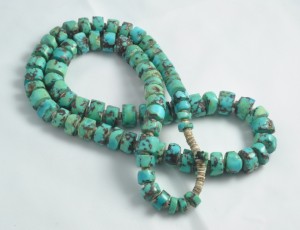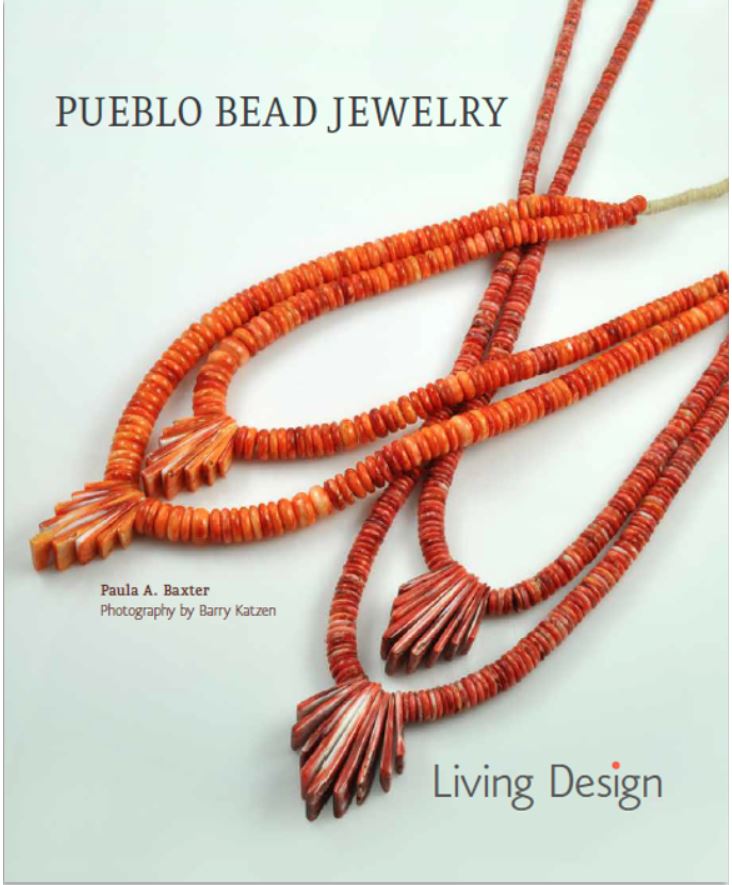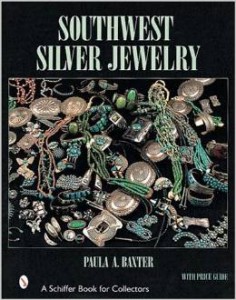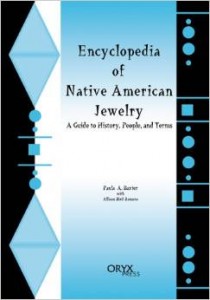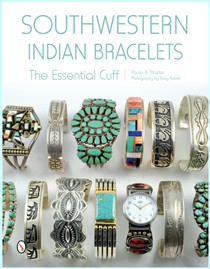Cultural tourism has various expectations which aren’t always fulfilled. The Plaza outside the Palace of the Governors nowadays reflects the subtle changes that impact all Americans. Tourists still arrive in Indian Country with outdated ideas about Native life and arts. The Indians they find under the portals in Santa Fe may be as savvy as those who work in Lower Manhattan art galleries. On the other hand, there are still many conservative Pueblo artisans who rely on selling their crafts in a tourist setting. Courtesy and an open mind are needed these days.
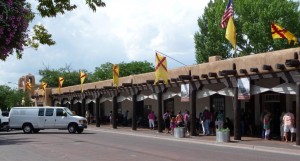 Palace of the Governors, Santa Fe, Palace of the Governors, the day before the crowds of Indian Market.
Palace of the Governors, Santa Fe, Palace of the Governors, the day before the crowds of Indian Market.
Like the Covered Wagon in Old Town, Skip Maisel’s store in downtown is one of the most famous curio shops along Route 66. Indian-made jewelry from Maisel’s shop, even though much was bench-produced, serves as popular vintage collectibles. The store is still going strong today and acts as many tourists’ introduction to souvenir Indian arts. Works by notable jewelers figure in the front cases, but the real goods—lots and lots of them—are the mass-produced necklaces, bracelets, pendants, and rings that line the aisles.
As always, what’s unfortunate is that these goods can be perceived as representing what genuine Indian-made arts are like. The fact is that curio jewelry usually is stuck in a mid-20th century stylistic time warp, reflecting designs that are called “traditional” and “classic.” In my forthcoming book, Southwestern Indian Bracelets: The Essential Cuff, I’ll be examining what really lies behind these labels and why they denote value judgments both good and bad.
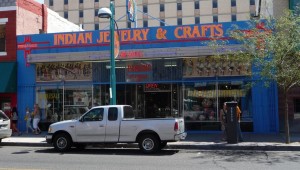 Maisel’s Indian Jewelry & Crafts store, Albuquerque
Maisel’s Indian Jewelry & Crafts store, Albuquerque
Over the years I’ve been collecting Indian arts, I’ve occasionally run into individuals who express fascination with Native-made medicine bundles. Most of the time this interest stems from the New Age-shamanistic appreciation of American Indians; it’s a forlorn hope not to expect some of this starry-eyed attitude on the part of non-Indians. It’s certainly true that many spiritual beliefs from Native culture are beautiful, and attractive to pursue.
But I always cringe when I learn that some people believe medicine bundles made for Native individuals are yet another category of collectible. Genuine medicine bundles are made for a specific person, blessed, and have efficacy only for the person who carries them. This “power” is not transferable to any other persons, Native or otherwise. The materials that go into medicine bundles of earlier decades can include remarkable fetish-like carvings. Nevertheless, the collecting of medicine bundles isn’t appropriate. There are those who tell me and others, in quiet tones, that such an acquisition can bring ill luck to the collector.
Another major point to consider: almost all the medicine bundles available on the market are bogus. Don’t go there.
 Gallup evening clouds
Gallup evening clouds
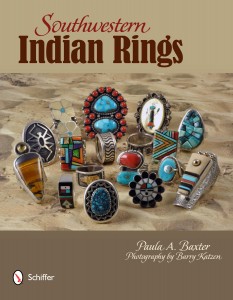 Southwestern Indian Rings
Southwestern Indian Rings
by Paula A. Baxter
Photography by Barry Katzen
Visit Amazon for its discounted price
With a fascinating variety of American Indian rings from the southwestern United States shown in more than 360 color photos, Southwestern Indian Rings
provides a design history of these rings, beginning with pre-contact artifacts and continuing through to contemporary artistic innovations.
The text surveys key developments in Native American ring design; materials and methods of construction; definitions for historical and vintage rings; master innovators; and the transition from craft to wearable art since 1980.
Shortly after the Civil War, Native American artisans began making silver rings set with turquoise, coral, jet, mother-of-pearl, and colored shell, adding lapis, malachite, onyx, and petrified wood over the decades. More recently, artisans began utilizing gold and such non-traditional settings as opals and diamonds, among others.
Works by Navajo and Pueblo artists are featured, although Apache, Northern Cheyenne, and Sonoran Desert Native jewelers are also included. A guide to valuation issues and resources is offered for collectors.
978-0-7643-3875-5
hardcover $34.99 (but Amazon is giving a discount)
8 1/2 x 11
160 pages
361 color photos
I’ve written an article on this topic for the August issue of The Journal of Antiques and Collectibles. Collectibles have grown as a consumer fancy for collectors over the last thirty years. American Indians have been a source of fascination to non-Native peoples for a long time. Indian collectibles, however, reflect some of the cultural stereotypes and inaccuracies assumed by non-Indians. Most 20th-century school children grew up thinking that tomahawks, canoes, drums, feathered headdresses and beaded items were representative of Indian culture in general. Hollywood didn’t help matters by making all on-screen Natives into Plains Indians.
The small-sized items produced for sale at Fred Harvey Company hotels, restaurants, and tourist outlets — like Desert View on the South Rim of the Grand Canyon — are amazingly popular and have kept their collectible nature. Prices were quite low, especially for manufactured goods, until this past decade. Collectors examining Fred Harvey objects such as jewelry are experiencing sticker shock these days. As more and more individuals have taken notice of a unique form of Americana, those small bracelets with stamps of horses and whirling logs or strands of turquoise shaped by Santo Domingo Indians, have seen a 20-35% increase in sale price.
Do you begin to sweat when you walk into a store, gallery, or exhibit space that offers Indian arts for sale — especially arts that you collect? I’ve had this particular affliction since 1986. It does NOT get better over time. There are two kinds of places that affect me most: 1) new emporiums I’ve never visited before, and 2) the shops of the Heard Museum and Museum of Northern Arizona.
At times, depending on the weather, I have to carry a small terry cloth with me to wipe the sweat away from my face and keep it from landing on the desirable objéts I am looking over. Buying a four-pack of terry baby wipe cloths is a good investment. Other people will sidle up to me and whisper that they have the same condition. One woman told me she got so excited during a Crownpoint Navajo Rug Auction, she had to run outside the school building to cool down. Straight into below freezing weather. Years ago, we attended an auction at Crownpoint in November. We bid successfully on three small weavings. We lurched all the way to Gallup that night on icy, snowy roads — and the entire time we forgot to turn on the heater!
At this point, a collector finds that he or she is ready to entertain the idea of people — the object’s creators. It can be embarrassing to admit that one collects for a period of time without thinking about the creators, but many collectors admit that this is precisely what they have done. Many times, collectors begin to forge bonds with their suppliers. These dealers, vendors, and shop owners often suggest artists to meet, and then collectors start on the show circuit.
I still remember a crucial moment, about four years into my collecting, when a Navajo gallery dealer quietly advised me to take a good look at the people who made objects I wanted to purchase. I followed through at the Gallup Intertribal Ceremonial, and I learned that those objects I loved so much had people behind them.
Well, now the collector is amassing objects, and has begun to sort out some personal feelings about what is wanted and needed for a collection. The educational process begins around this point. I discovered that if I was going to spend my money like a drunken sailor, I did want to know more about the materials my object of desire was made with. For me, this meant learning about silver — coin silver, German silver, sterling silver, silver with alloys. Oh, and then, there’s the turquoise…
Books are needed! Once the collector becomes truly primed, the need to learn, evaluate, and judge based on knowledge becomes a driving force. In my case, it led me to begin writing on the subject when the variety of books out there wasn’t enough to satisfy my questions. Today, Amazon and the online used book market make the hunt for education an easier process than it was back in the 1980s.
One object isn’t enough, oh no! The new collector is ready to embark willy-nilly on a hunt for objects like the ones in his/her possession. Frankly, new collectors can’t get enough exposure to these objects. If you don’t live in the Southwest, you comb through local shops, dealers, and shows. It only took one trip for me to realize that big successful enterprises like the Brimfield (MA) antique shows are NOT the place to find one’s objects of desire. A savvy dealer has been there the day before and taken anything of note. New collectors need to understand these realities before expending too much manic energy in fruitless hunts.
Sometimes hunts prove beneficial after the fact. We started visiting trading posts on the Navajo reservation in the late 1980s and early 1990s. Some had already stopped being genuine sources for Indian arts. Yet we discovered an affordable and fantastic rug at the Crystal Trading Post and a saddle blanket at Shonto, and learned about the historical importance of trading posts, even though their day had passed by the mid-1970s. New posts, operating like galleries are less plentiful, but when you hunt down one like Twin Rocks Trading in Bluff, Utah, it’s like hitting a bulls-eye!
